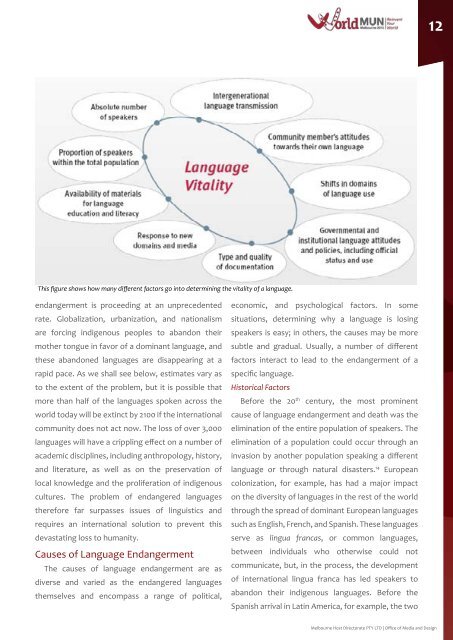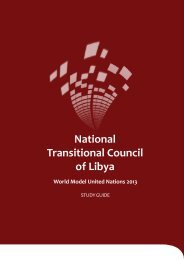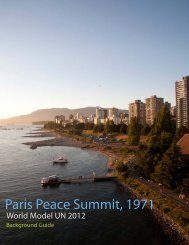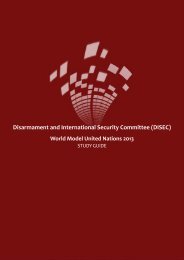Social, Humanitarian and Cultural Committee (SOCHUM)
Social, Humanitarian and Cultural Committee (SOCHUM)
Social, Humanitarian and Cultural Committee (SOCHUM)
You also want an ePaper? Increase the reach of your titles
YUMPU automatically turns print PDFs into web optimized ePapers that Google loves.
This figure shows how many different factors go into determining the vitality of a language.<br />
endangerment is proceeding at an unprecedented<br />
rate. Globalization, urbanization, <strong>and</strong> nationalism<br />
are forcing indigenous peoples to ab<strong>and</strong>on their<br />
mother tongue in favor of a dominant language, <strong>and</strong><br />
these ab<strong>and</strong>oned languages are disappearing at a<br />
rapid pace. As we shall see below, estimates vary as<br />
to the extent of the problem, but it is possible that<br />
more than half of the languages spoken across the<br />
world today will be extinct by 2100 if the international<br />
community does not act now. The loss of over 3,000<br />
languages will have a crippling effect on a number of<br />
academic disciplines, including anthropology, history,<br />
<strong>and</strong> literature, as well as on the preservation of<br />
local knowledge <strong>and</strong> the proliferation of indigenous<br />
cultures. The problem of endangered languages<br />
therefore far surpasses issues of linguistics <strong>and</strong><br />
requires an international solution to prevent this<br />
devastating loss to humanity.<br />
Causes of Language Endangerment<br />
the causes of language endangerment are as<br />
diverse <strong>and</strong> varied as the endangered languages<br />
themselves <strong>and</strong> encompass a range of political,<br />
economic, <strong>and</strong> psychological factors. in some<br />
situations, determining why a language is losing<br />
speakers is easy; in others, the causes may be more<br />
subtle <strong>and</strong> gradual. Usually, a number of different<br />
factors interact to lead to the endangerment of a<br />
specific language.<br />
Historical Factors<br />
Before the 20th century, the most prominent<br />
cause of language endangerment <strong>and</strong> death was the<br />
elimination of the entire population of speakers. The<br />
elimination of a population could occur through an<br />
invasion by another population speaking a different<br />
language or through natural disasters. 14 european<br />
colonization, for example, has had a major impact<br />
on the diversity of languages in the rest of the world<br />
through the spread of dominant european languages<br />
such as English, French, <strong>and</strong> Spanish. These languages<br />
serve as lingua francas, or common languages,<br />
between individuals who otherwise could not<br />
communicate, but, in the process, the development<br />
of international lingua franca has led speakers to<br />
ab<strong>and</strong>on their indigenous languages. Before the<br />
Spanish arrival in Latin America, for example, the two<br />
12<br />
Melbourne Host Directorate PTY LTD | Office of Media <strong>and</strong> Design

















